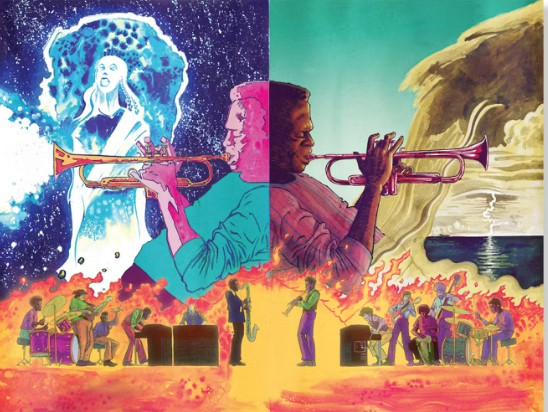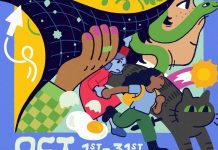Ahh, jazz and comics, two realms of artistic expression that weave intricate tapestries of personal connection that are profound. To immerse oneself in the creation or appreciation of these mediums, whether highly disciplined or totally freestyle, demands an unwavering dedication. The mastery of their extensive vocabularies is arduous, a symphony of commitment and time. Nevertheless, the undying allure of these art forms lies in their inherent nature to defy conventional norms. Any way you slice it, jazz and comics are most celebrated when they pursue audacious innovation and perpetual adventure via artistic exploration. When hallowed rules are boldly challenged and gracefully bent, the outcome is nothing short of mesmerizing.
Dave Chisholm’s jazz explorations via comics have been nothing short of enthralling. Over the last several years, Chisholm has written and illustrated illuminating works that integrate jazz with the comics form. Chasin’ the Bird, which followed the great Charlie Parker, and Enter the Blue, which explored the mystical existence of Blue Note records, were both stunning work as well as entertaining slices of fantastic jazz-integrated storytelling. But now, Chisholm has undertaken a project featuring, undisputable, the most respected figure in all of jazz history.
Imminently, Z2 will release Chisholm’s new graphic novel: Miles Davis and the Search for the Sound. Described as a “synesthesia-inducing graphic novel that follows the many lives of [a] music legend,” Chisholm explores the many eras and styles of Miles as the trumpeter seeks his next big sonic escapade. The following is a conversation about the new book.
AJ FROST: Hi Dave! Thank you–again–for taking the time to chat with me about your latest book. So tell me, you tackled some big names in the jazz world: Charlie Parker and Blue Note Records were the subjects of your last two books. Now you’re going for the GOAT: Miles Davis! How did this project originate? Did you go to the Miles Davis estate or did they come to you for this book?
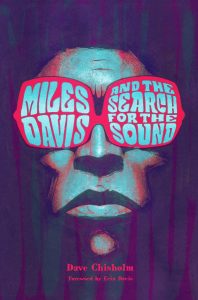
DAVE CHISHOLM: Well, as far as I know, basically the people who manage the Charlie Parker estate got a copy of my 2020 book Chasin’ the Bird to Miles’ son Erin. Erin then came along with the general idea “what if…?”; he was impressed with the Parker book. Connections were made and, due to the quality of the Parker book, I was asked to make a story pitch for a Miles book. As a trumpet player and lifelong Miles fan, it was obviously a lot of pressure but also a fun challenge to put the pitch together. I knew I wanted to tell a story that spanned Davis’ whole life, but that wouldn’t fit in the 150-page limit I was given. It became clear that I needed some kind of editing dictum, a clear way to know which parts of his life to not depict, which is where the SEARCH FOR THE SOUND came in! Anyway, it was approved and it was full-speed ahead!
FROST: How can you tell the story of someone like Davis who had so many monumental moments in his life in only 150 pages? The ideas for the book must have been endless!
CHISHOLM: Honestly… Well, you know I am obsessed with comics form, particularly having style mirror content, right? Like how, in the Parker book, each chapter changed its visual style and storytelling style based on the POV of the narrator? I knew right away–it had to be this way–that I wanted to use the comics form to mirror the content of his music throughout the book, which is why I was stubborn and insistent on putting his whole life in there. It was a really nice challenge to tackle rather than deciding to tell the story from, say, 1956-1970 or the story of one concert or one era or whatever. This was the story I wanted to tell particularly because I could use the various elements of comics form to capture visually/symbolically the actual MUSIC during his whole life—which is the part that music biographies in just about every medium gloss over, right? And for Miles: his stylistic shifts, his endless artistic courage, his restlessness… that’s one of the most notable and fascinating things about him! So it had to be this!

FROST: But did you have any specific events in Miles Davis’s life that you found particularly perplexing or rewarding to depict?
CHISHOLM: Yeah… The music! Sorry if that’s an obtuse answer, but I think it’s central to the narrative of his life. It’s his main obsession and I wanted to do it justice using the elements of comics. Everything in this narrative branches out from the music itself, and so a convincing visual representation was a must… and was a challenge.
FROST: Do you feel that you borrowed some cues from Miles when you infused the storytelling and visuals of your book with the same spark of spontaneity and creativity found in jazz improvisation?
CHISHOLM: I think a few processes in comics-making feel akin to jazz improvisation, especially when you work traditionally. My pencils tend to be quite loose, which then gives the whole inking process an edge. It requires a bit more mindfulness, right? And if I slip up and make a mistake, my goal is always to find a way to make the wrong thing right, kind of like Miles’ quote about right/wrong notes that’s in the book. A lot of the values/textures you see in the colors is also done traditionally with colored pencil or colored ink washes–I adjust the hues in Photoshop later on–and that process honestly feels even more permanent than typical black inkwork. Any mistakes must be accepted and turned into an advantage, a motif, or whatever.
FROST: What artistic and storytelling choices did you make to distinguish the different phases of Miles Davis’s musical and political journeys? What coloring or penciling techniques did you utilize to differentiate mood or era? Are there any particular panels or sequences that you’re especially proud of? Are there any that hold a certain personal significance for you because, as you said, you’re a trumpet teacher and jazz professional?
CHISHOLM: I tried to use as many techniques as I could to capture the music of each era. Every aspect of page design–panel layouts, panel shape, panel flow, panel transitions–that might be more rigid and controlled earlier in his career (not counting the chaotic stage in which Davis’ addiction gets the best of him) to more and more overlapping panels as his music and trumpet playing increases in complexity through the ‘60s, to the bending and breaking of boundaries through his own boundary-breaking seventies work. The tools I used shifted as well: with an austere dead line during his own minimal, restrained playing in the late ‘50s, with big swaths of heavy black shadows, to a heavily detailed nib line for his wonderfully detailed collaborations with Gil Evans, to very expressive chunky brushwork in the ‘70s, all the way to some pretty gnarly, spatter-filled pages during his reclusive dark era in the late ‘70s.
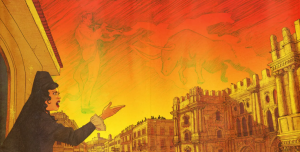
And color played a HUGE part in all of this: first, the only use of one particular blue-green color happens when Miles himself is playing—that’s a throughline connecting everything together, Miles’ trumpet playing–and then the overall color palette shifts with each chapter: the early chapter depicting his apprenticeship with Bird is colored with the same magenta emphasis that you see in Chasin’ the Bird. Later chapters get inspiration largely from the colors from the sleeve art of particular albums from each era. There’s more than this but, honestly, it makes me even a little weirded out spelling this stuff out in such detail! I really want people to discover this on their own, or find their own interpretations!
FROST: What makes comics an effective medium for telling the story of a jazz legend like Miles Davis? And working on a book about Miles is such a significant undertaking…
CHISHOLM: Well, first and foremost, comics are great for telling any story! So that’s my blanket answer. But jazz and American comics have similar trajectories: they are both outsider art forms spearheaded and innovated by virtuoso members of marginalized populations. They are also outsider art forms in sort of ‘high’ culture but popular art forms to the masses that eventually found their way towards some kind of larger acceptance into the canon of so-called “high art.” It’s a cool kind of parallel history.
FROST: What message or thematic through line do you wish readers—those who are fans of Miles or who have never heard of him—take away from your book? Do you believe your book will introduce Miles to a new generation of readers who might not be familiar with his work?
CHISHOLM: Honestly, I’m proud as hell of the whole thing. The Gil Evans stuff is so close to my heart and I’m happy with how that chapter turned out, indeed how every chapter showcasing this friendship–Miles’ longest friendship–turned out. It’s hard for me to pick my favorite though. The ‘70s eras were really loose and fun to make. The Live-Evil spread turned out great and I adore that extremely weird album. But I also love how the Bird chapter worked!
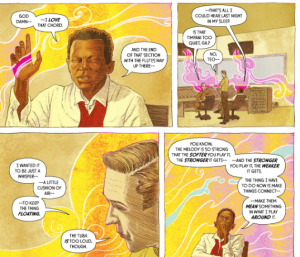
With this book, I really wanted to use Davis’ music itself as a path into exploring his Jekyll-and-Hyde, Gemini nature. I mean, he’s a bundle of contradictions, right? Without knowing his music, in a lot of ways you see this guy who is an embodiment of “toxic masculinity” in what he projects outward, but his music, his trumpet playing, is anything but that kind of cliche “masculine” trumpet playing; he doesn’t do that HIGHER! FASTER! LOUDER! kind of shit. It’s achingly vulnerable, gorgeous, expressive, and he’s incredibly sensitive to the musicians around him. He’s always reacting in an unexpected and perfect way. So which is the “real” Miles? This aggressive, occasionally violent guy with a troubled relationship with the women in his life? Or the supportive, nurturing, sensitive musician and bandmate? Ultimately, he’s both, and this collection of contradictions is what makes him so compelling, beyond his amazing and challenging music!
FROST: Were you nervous to depict Miles’ darker, Jekyll side? Did his heirs and family approve (or need to approve) the more troublesome parts of Miles’ life?
CHISHOLM: Hmm.. I knew that, to really paint as complete a picture of the man as I could, I’d have to depict him in some less-than-great moments, both things Miles did and things done to Miles. The line to walk is to depict these moments of violence tastefully, to perhaps imply them without showing them or to show them without reveling in them or making them look super-comic-book-badass in the way too many comics depict violence. With the family’s permission, basically, it boiled down to the fact that Miles himself was candid about this stuff in his own autobiography. They didn’t want a watered-down portrait of him either, thankfully. And, yes, throughout the process, every page of script and final art was to be approved by Erin, who is Miles Davis’ son. The whole process was pretty great.
FROST: As you prepped the work on this book, what pieces of art did you go to for inspiration? I’m not even talking about Miles’ discography, which I’m sure is a given. Did you read any comics that got you into the spirit to create?
CHISHOLM: I mean, all the usual suspects, to be honest. I read the same books as everybody else, there are no surprises in my to-study list! [Laughs]
FROST: Is it sacrilegious to ask what your favorite Miles record is?
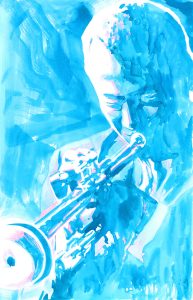
CHISHOLM: I think I’ve gotta go with MILES AHEAD, SKETCHES OF SPAIN, PORGY AND BESS, and LIVE-EVIL in a four-way tie! But really he’s got the most insane body of work. His run of albums WALKIN, COOKIN, STEAMIN, RELAXIN, ‘ROUND ABOUT MIDNIGHT, MILES AHEAD, MILESTONES, PORGY AND BESS, KIND OF BLUE, SKETCHES OF SPAIN—those all came out in like three years of each other. Unreal! I mean it when I say that nobody will ever top a run of records like that. I’m probably missing one or two! It’s absolutely mind blowing in quality and breadth of styles!
FROST: Was there anything that you were just dying to include, but due to constraints on page count or time, you simply couldn’t?
CHISHOLM: Oh man, so many things. I’m bummed I didn’t have space for more good experiences from his childhood, particularly his early years playing trumpet. To be frank, that’s probably my biggest regret. If I only had one more page! But also a scene in the studio with his second quintet—since that group was so so different in the studio versus how they operated live in terms of repertoire and risks. Just as vital, somehow, too! And it’s a bummer that the album Milestones doesn’t even get mentioned. I should also add that the framing device of his early 1980s stroke basically relegates his final decade into a short coda chapter which is also too bad. But still, I’m beyond happy with how it turned out and I stand behind my decisions to edit out what I did!
FROST: Are there any other jazz icons on your radar for the ol’ graphic novel treatment?
CHISHOLM: In terms of other jazz icons, I mean, Charles Mingus is a huge influence on me but there’s a Mingus book [from NBM] that just came out so I doubt that’d happen any time soon. I don’t know… With the music books, I’d love to branch out from jazz, to be honest. Jazz represents only a small wedge of the music I love!
FROST: Last question for now: Where do you go from here? Do you have anything in the works that you’re willing to share?
CHISHOLM: Right now I’m working on a really amazing 6-issue comic written by my brilliant friend Rick Quinn that’s slated for 2025 release. It’s this amazing reimagining of an alternate 20th-century music history, told with the genre-bending frenetic energy of EVERYTHING EVERYWHERE ALL AT ONCE, all told from the points-of-view of two ground-level characters experiencing and involved in all of this weird, magical, music-related stuff. It’s turning out fantastic. High hopes for this one!
Miles Davis and the Search for the Sound comes out from Z2 on November 7th, 2023. Learn more about Chisholm’s work on his website, Instagram, and Twitter.


